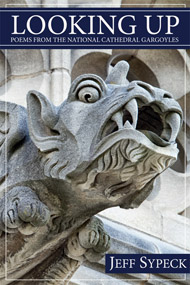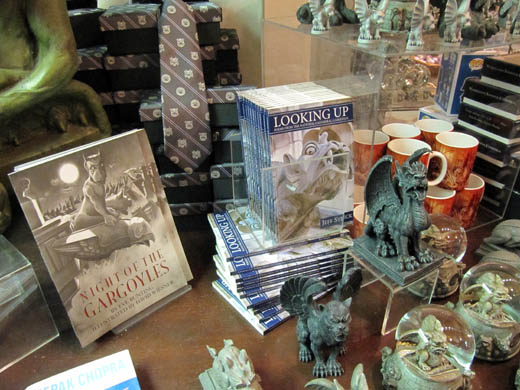 When you put a small book out into the world, especially a book of poems, hope takes unexpected forms, including the graceless prose of a purchase order. Four years after its debut, Looking Up: Poems from the National Cathedral Gargoyles continues to find readers: Two weeks ago, the National Cathedral gift shop ordered its eighth batch of copies, which I packed up and happily delivered by hand.
When you put a small book out into the world, especially a book of poems, hope takes unexpected forms, including the graceless prose of a purchase order. Four years after its debut, Looking Up: Poems from the National Cathedral Gargoyles continues to find readers: Two weeks ago, the National Cathedral gift shop ordered its eighth batch of copies, which I packed up and happily delivered by hand.
Whether bestsellers or self-publishers, most writers observe a taboo against discussing book sales, but I’m happy to share my own experience: So far, I’ve sold nearly 250 copies of Looking Up. That strikes me as pretty darned good for a self-published book of medieval-influenced neoformalist verse with a P.R. budget of zero and only one real-world sales venue. The majority of copies have sold through the cathedral gift shop—and the thought of their visitors flipping through a physical book and then feeling inspired to buy it thrills my old-fashioned soul.
A look at a spreadsheet last week gave me a second piece of good news: This project is now profitable! I’ve told the cathedral I’ll donate 75 percent of the net proceeds to their earthquake-repair fund, and after more profits accrue, I’ll do just that. It may not be the biggest gift the cathedral ever gets, but I’m sure they’ll be glad to receive it.
If you’d like a copy of Looking Up, here’s what to do:
Buy it from me. Email me (jeffsypeck -at- gmail -dot- com) and I’ll get a copy to you. The book is $14, with shipping based on where you live. You can do Paypal, a check, whatever works.
Order it through Amazon (and its international variants: .de, .es, .fr, .it, .uk), Powell’s, or the online retailer of your choice. I’m not always happy with how the cover prints when you order from these sites, but it’s a quick, convenient way to get copies.
Buy it at the National Cathedral. If you’re in D.C., please pick up the book at either of the cathedral’s two gift shops. You’ll be helping to keep it in stock. (If for some reason you’re okay with paying $12 shipping, you can order it through their online store.)
Of the 53 poems in Looking Up, all but two of them began on this blog; you can browse the first drafts of those 51 poems here. I appreciate everyone who cheered on these poems during the three years they bubbled and churned into being, and I’m grateful to everyone who’s picked up a copy of the book since 2012. I’d love to double the current sales over time—and wouldn’t it be something if poetry, and poetry readers, could help replace a fallen stone or straighten a crooked spire?


Yes, that’s excellent for a book published that way–and just as good as many a book of poems published more conventionally. I started a list of books for gifting on Facebook–be sure and add it!
And, all you passers-by, I own this–and you can too.
LikeLike
Thanks, Marly! It’s hard to know when and how to discuss sales figures, since almost no one ever does. I figure some people will find the numbers high for a book of poetry, while others will find them low based on some other reference point. I really do hope to double sales over time, as long as the cathedral gift shop folks continue to agree with me that the book has no expiration date.
LikeLike
Some of my European contacts who edit magazines and publish academic monographs have been pretty open about numbers. With commercial publishing, I think the publishers are sometimes worried about giving their competitors a trade advantage by revealing sales data. I know one publisher which took down their search engine which let anyone with a browser see sales figures for particular ebooks.
Oxford University Press have moved to Print on Demand for some of their Oxford Classical Texts. O great scandal!
LikeLike
Sean, it’s good to hear that people in the academic world are being open about sales figures; so many things in academia could use greater transparency.
And good for OUP! The existing model makes economic and logistical sense only because the infrastructure is already paid for and the system is long entrenched, but in 2016 it’s silly to print stacks of books based on sales projections, store them in warehouses, and move them around. There’s much I’d like to see change in publishing; that’s a good start on the part of OUP, and I suspect it’ll prove profitable in the long run.
LikeLike
Indeed, PoD opens up some new opportunities (although people who have done the math show me some un-intuitive things). Osprey also prints some books that way.
That said, the real obstacles that my publishing faces are human or financial (from reviewers who “reject” rather than “revise and resubmit,” to busy co-authors or editors, to publishers who can’t find time and money to print and market the volume, to doubting that I could find a market for what I want to write).
LikeLike
As one of the nearly-250 owners of this book (who just happened to wander back past your blog today), I wanted to say that it’s really lovely, and some of your lines come back to haunt me at reflective moments, years after I first read them. Canterbury Bells, Kinderlied, and A Mother Consoles Her Daughter are my favorites.
No point to make–just thank you for writing them.
LikeLike
Sean: I hear ya. Other writers I know, whether poets, scholars, novelists, or nonfiction writers, are dealing with the same problems. In recent months, I’ve gotten three rejections from poetry journals and one peer-reviewed academic journal. I’m convinced that nearly everything has a market of some size or another; I wish finding those markets weren’t still so hard.
Mary: Thank you! Hearing that some of the gargoyle poems stayed with you for so long has already made my Thanksgiving week. I’m truly grateful to you for taking the time to stop by and comment.
LikeLike
Hmm, numbers. Well, I was told by an editor whose company was dropping their poetry line some years back (glad to say that they revived the line since) that none of their poetry books had broken the 300-mark. So that tells you a lot. I’ve been told that some Copper Canyon can get to 600, which is pretty much the outer limit for books sold in the usual way by a publisher. (Unless you are Billy Collins or Mary Oliver, I suppose. Maybe Wendell Berry…) That’s all I know about numbers, aside from a few of my own. I know that The Foliate Head sold out both printings, but I’m not sure how big they were. Thaliad is now around 400, I think. I have no idea about others.
The advantage of a small, consistent outlet seems very great. Your book is displayed well, not lost in a spine-out shelf. They like it and want to continue to support it. Grand situation for a book that could get lost so easily.
LikeLike
I was quoted about a hundred copies for an academic monograph by a not-so-famous professor from one of the continental European academic presses (not sure whether he notices a difference between publishing in English and in German). Another source estimates 200 to 300 sales to libraries http://dx.doi.org/10.3998/3336451.0011.201 or 400 to 500 hardback sales worldwide http://www.sr.ithaka.org/publications/the-costs-of-publishing-monographs/?cid=eml_monographreportFeb2016#post-276785-footnote-4
In an age when 450 pages is a short novel, there is something to be said for concision and poetic elegance!
LikeLike
some Copper Canyon BOOKS, it should say
100 copies. Interesting. Of course, a library sale may mean more readers. Or more dust-gatherers.
LikeLike
Sean and Marly, thank you both for some “anecdata” on sales of various genera of books. One interesting book at the confluence of scholarly and poetry publishing is the recent translation of Aldhelm’s Riddles by A.M. Juster. As far as I can tell, the book appears to be selling pretty well, perhaps in part because the University of Toronto Press offered us readers a lower-cost paperback option. I’m not one of those people who claims to have a clear solution to problems in publishing, but I do advocate that they not take a one-size-fits-all approach and treat each book as unique, with a unique audience awaiting it. My hunch is that investments in niche marketing would pay for themselves…but I’m just one tiny writer with some notions.
LikeLike
I just met with a young writer debating what to do with her first book. We discussed the options (I didn’t lean one way or another, though I was pretty frank about problems with all options.) And now she has decided to do the book as a self-published novel. I will be interested to see how she manages distribution, as she seems to have done a good deal of research….
Yes, it would be good to have individual discernment and marketing. Don’t think that’s the trend, alas. Good marketing was always rare. We just didn’t understand that publishers decided what books would sell, as best they could, via the lead book system. And poetry is never lead book unless maybe you are Billy Collins or Mary Oliver.
I reviewed the riddles as well, I guess you know. Maybe we talked about it? Michael is an interesting case–a person extremely well known in another field and also adept at building his life in poetry. I think he’s rare!
LikeLike